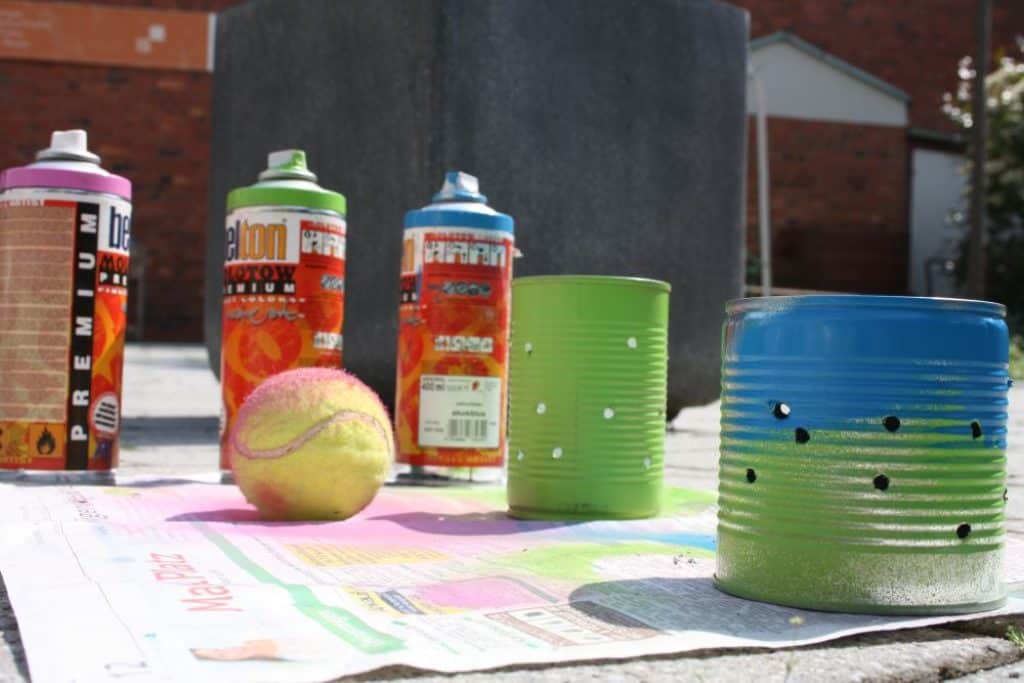Is Spray Paint Waterproof? (Explained In Detail)
Before starting a paint project in or around your home, you may have selected spray paint as probably the easiest way to do the job.
And, depending on the type of the job, you may have wondered is spray paint waterproof.
The first thing on mind for most homeowners when shopping for spray paint is the tone and texture.
People want the painted surface to look good and fit well with whatever’s surrounding it.
In addition, spray paint is often chosen because it’s so easy to use and doesn’t leave a big mess behind.
Still, you should also be concerned with what happens after painting and how the paint will hold up.
Durability and long-lasting finish should also be factors, particularly for paint jobs that take place outdoors and leave the surface exposed to weather elements.
A particularly important aspect is how it will fare in wet conditions.
Table of Contents
Is Spray Paint Waterproof?
The answer to this question is not that simple as it may depend on several factors. Mostly the type of spray paint.
Generally speaking, spray paint isn’t necessarily waterproof.
However, due to the different kinds available on the market, this may not be true across the whole range of spray paints.
In fact, most of them will offer at least some degree of protection against water, especially those for outdoor use.
The different levels of water resistance among various types of spray paints are mainly related to their physical and chemical properties, so some will be more waterproof than others.
Certain kinds are more elastic, capable of expanding and contracting without splitting the paint coating, thus allowing the moisture to evaporate.
Others provide a durable, rubbery coat that is impenetrable to water.
You can even make some less waterproof types more resistant to moisture by applying sealer or varnish.
Different Types of Spray Paint and Their Resistance to Water
As I already explained, there are various types of spray paint, each with its own properties and, therefore, different levels of resistance to water.
Below are the most common types of spray paints used for various purposes, along with an explanation of how waterproof they are.
Acrylic Spray Paint
Acrylic spray paint features a typical matte finish, so it doesn’t provide a glossy coating most waterproof paints are known for.
Still, they can withstand water to a certain degree. So, it would be more accurate to call them water-resistant than waterproof.
When exposed to larger amounts of water, such as during a hard rainfall, the paint will likely soften and slowly allow water to pass through.
However, when it comes to the normal amount of moisture exposure, it can hold up pretty well.
Some types of acrylic spray paint can offer even more water protection, particularly those intended for exterior use.
They form a flexible and rather impermeable surface layer capable of coping with rainfall.
For an even higher level of waterproofing and water protection, you can use waterproof sealants to seal the acrylic finish.
The best options for this purpose are polyurethane, varnish, or enamel.
Enamel Spray Paint
This type of spray paint is known to provide a very glossy or shiny finish, typical of paints with solid waterproofing properties.
In addition, enamel spray paint is very fast drying which helps protect the surface, especially if the paint job is done during unfavorable weather conditions.
Still, while it will provide a solid level of water resistance, enamel spray paint will likely not fare very well when exposed to moisture repeatedly over time and won’t hold up that well in particularly humid conditions.
Latex Spray Paint
Latex spray paint is another type that we can describe as water resistant, but not fully waterproof.
So, it can withstand a certain level of moisture without peeling or going bad.
Synthetic latex which is the main paint ingredient allows paint coating to stretch and hold up in a relatively moist environment.
This means that when the atmosphere around the coating gets moist, the latex particles become tightly packed which prevents water from penetrating through the coating.
Still, be aware that latex spray paint coating won’t thrive if there’s constant moisture exposure or heavy rainfall.
In this condition, the paint finish will most likely get damaged.
Similar to some other types of spray paints, you can make the latex paint more waterproof by using moisture-resistant sealants.
This is very helpful as latex paint is very popular for outdoor use as it can withstand prolonged exposure to sunlight without fading or getting damaged.
Epoxy Spray Paint
Epoxy spray paint can come in different types, depending on the kind of adhesives and polymers it contains.
Still, in most cases, they deliver a fully waterproof solution, especially convenient for outdoor use.
However, some epoxy paints may struggle to keep their integrity when painted outdoors as they don’t handle heat, frost, or abrasion very well.
Nevertheless, there are types of epoxy paints that don’t have these issues, which makes them very versatile and useful for all sorts of applications.
This is particularly true for high-heat epoxy paints, which contain silicone, epoxy phenolic, epoxy novolac, or multi-polymeric matrix.
Because of this, they can be used for painting ovens or outdoor items that are likely to be exposed to severe heat.
These kinds of epoxy paints are almost always fully waterproof,
Oil-Based Spray Paint
Oil-based paints are not fully waterproof but can offer some level of moisture protection, especially on certain kinds of surfaces.
However, using it on a rather porous surface, such as raw wood, can lead to water penetrating the coating and absorbing in the wood, causing the paint to peel off and damaging the wooden item itself.
Still, as it dries very quickly and keeps its color and tone for a long while, oil-based paint can be very useful, particularly in well-ventilated areas without too much moisture.
Chalkboard Spray Paint
Chalkboard spray paint is very popular among homeowners, especially those with large families as it can easily turn almost any surface into a blackboard for kids to write and draw on.
However, you should be aware that it offers minimal or no moisture protection at all.
They often absorb water, which is obvious as you can see wetness for some time after cleaning them with a sponge.
As the spotless surface is important for the most common uses of chalkboard paint, it’s recommended that you seal it with clear wax, varnish, polyurethane spray, or glaze.
How to Identify if Spray Paint is Waterproof?

Checking the Label
There are several ways to tell if a certain type of spray paint is waterproof.
Of course, the easiest method is to check the label, as it will most likely indicate whether the paint is waterproof or not.
If this information is lacking, you should consider that particular type of spray paint not to be waterproof.
You can also check the list of ingredients and look for those that commonly indicate waterproofing properties.
If you notice that the label contains works such as acrylic or alkyd, then you probably shouldn’t expect much in terms of water resistance.
Observing the Finish
If, for whatever reason, this type of information is unavailable, there are other ways of establishing if the paint will hold up against the water.
Once the paint dries, you’ll get a sense of what kind of finish it produces.
Spray paints that, when applied to the surface, create a more glossy finish, are more likely to be waterproof.
This also works the other way around. If the finish is textured or matte, the paint probably won’t hold up against the water well.
Testing the Paint
Testing the applied paint is another way of determining its level of water resistance. Apply the paint on a smaller surface, as you’re doing this only for these purposes.
Then, wait for it to dry and add a couple of drops of water to the finish.
If, after a while, the surface seems dry and the water is still clear and visible, then the paint is likely waterproof.
On the other hand, if the water has soaked into the finish, it’s a clear sign that the paint is not water resistant.
Also, even if the water is not absorbed, but seems unclear or tainted, this will mean that the paint has been dissolved and therefore, doesn’t have waterproof properties.
Conclusion
Learning how the spray paint stands up against water should be one of the priorities when picking the type and brand for your paint job.
While, overall, spray paint isn’t waterproof, there are certain kinds that have water-resistant properties.
Some of them are even fully waterproof.
So, it’s important to carefully consider the painting project in front of you and determine what level of protection against moisture is needed.
If the surface to be painted is in a dry and well-ventilated room, then almost any type of spray paint will do, and the choice should depend mostly on personal preference.
However, for surfaces that will be heavily exposed to moisture, you’ll need to pay particular attention when picking the type and brand of spray paint and, if needed, ask for professional help.



















































































